Report: Critical Analysis of Hofstede's Cultural Dimensions Framework
VerifiedAdded on 2020/10/22
|6
|1283
|312
Report
AI Summary
This report critically evaluates the application of Hofstede's cultural dimensions theory in a business context. It begins with an introduction to the concept of organizational culture and its five key factors: values, symbols, beliefs, rituals, and thought processes. The report then analyzes an article discussing Hofstede's framework, which includes dimensions such as power distance, individualism/collectivism, uncertainty avoidance, and masculinity/femininity. The analysis highlights the importance of cultural understanding in international business, emphasizing how cultural differences impact employee behavior and customer purchasing patterns. It also discusses how national cultures, like those in the US, Mexico, and various Asian countries, influence organizational practices. The report provides a justification for Hofstede's theory, illustrating how it helps organizations adapt to diverse cultural environments. Furthermore, it suggests strategies for international companies to foster effective workplace cultures, considering employee values and norms. Finally, the report concludes that understanding and adapting to cultural dimensions are crucial for business success in a global market. The report includes references to academic journals and online sources supporting the analysis.

Hofsted Theory
Paraphrase This Document
Need a fresh take? Get an instant paraphrase of this document with our AI Paraphraser
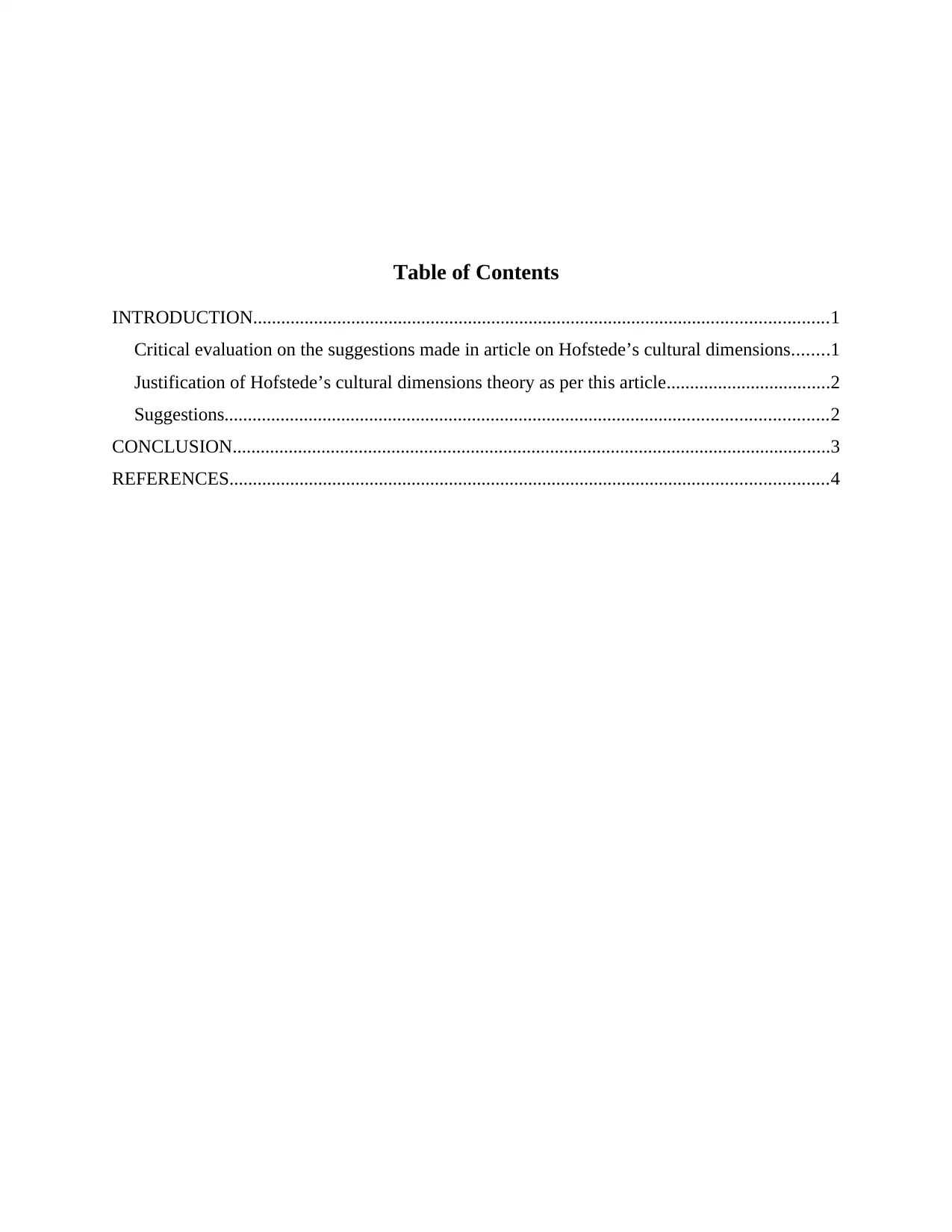
Table of Contents
INTRODUCTION...........................................................................................................................1
Critical evaluation on the suggestions made in article on Hofstede’s cultural dimensions........1
Justification of Hofstede’s cultural dimensions theory as per this article...................................2
Suggestions.................................................................................................................................2
CONCLUSION................................................................................................................................3
REFERENCES................................................................................................................................4
INTRODUCTION...........................................................................................................................1
Critical evaluation on the suggestions made in article on Hofstede’s cultural dimensions........1
Justification of Hofstede’s cultural dimensions theory as per this article...................................2
Suggestions.................................................................................................................................2
CONCLUSION................................................................................................................................3
REFERENCES................................................................................................................................4
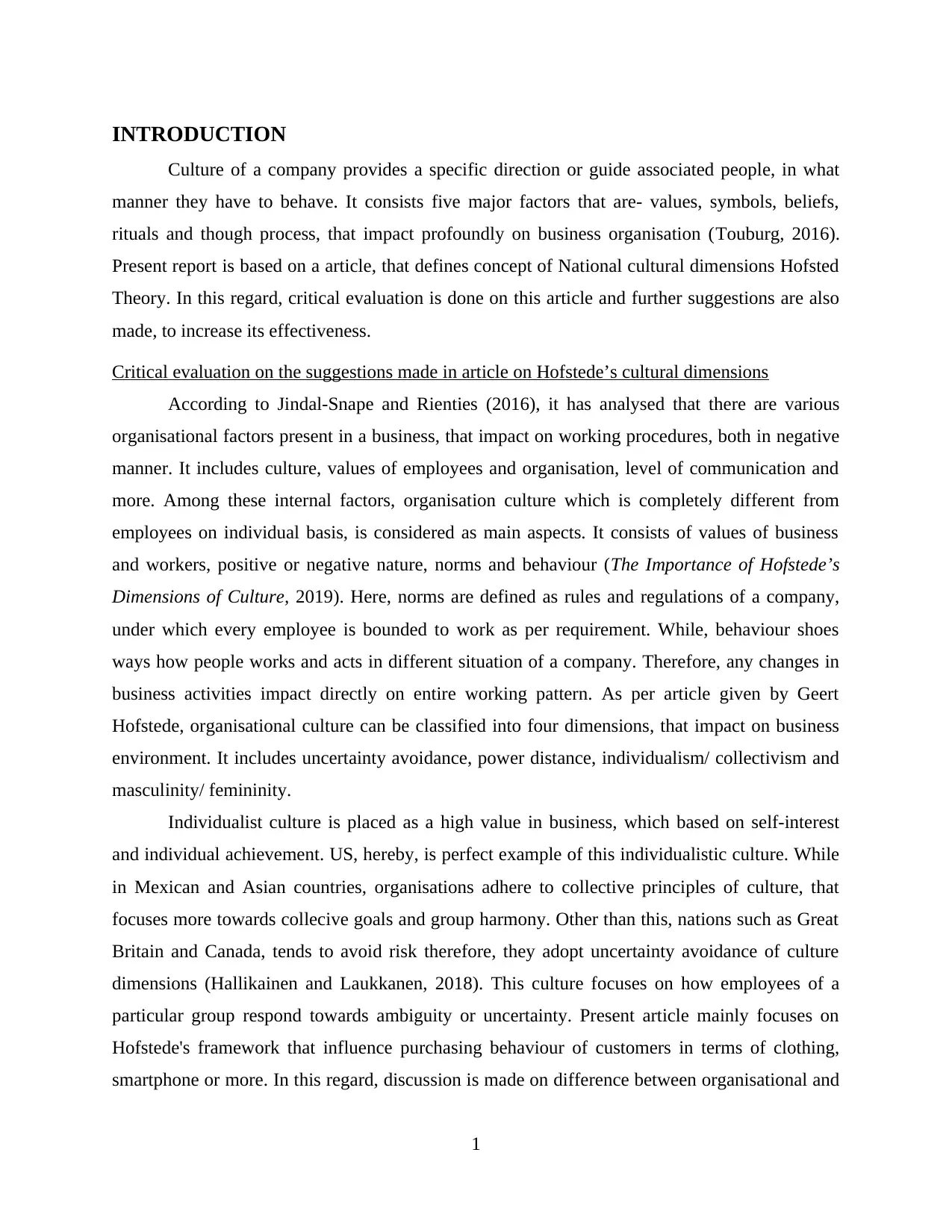
INTRODUCTION
Culture of a company provides a specific direction or guide associated people, in what
manner they have to behave. It consists five major factors that are- values, symbols, beliefs,
rituals and though process, that impact profoundly on business organisation (Touburg, 2016).
Present report is based on a article, that defines concept of National cultural dimensions Hofsted
Theory. In this regard, critical evaluation is done on this article and further suggestions are also
made, to increase its effectiveness.
Critical evaluation on the suggestions made in article on Hofstede’s cultural dimensions
According to Jindal-Snape and Rienties (2016), it has analysed that there are various
organisational factors present in a business, that impact on working procedures, both in negative
manner. It includes culture, values of employees and organisation, level of communication and
more. Among these internal factors, organisation culture which is completely different from
employees on individual basis, is considered as main aspects. It consists of values of business
and workers, positive or negative nature, norms and behaviour (The Importance of Hofstede’s
Dimensions of Culture, 2019). Here, norms are defined as rules and regulations of a company,
under which every employee is bounded to work as per requirement. While, behaviour shoes
ways how people works and acts in different situation of a company. Therefore, any changes in
business activities impact directly on entire working pattern. As per article given by Geert
Hofstede, organisational culture can be classified into four dimensions, that impact on business
environment. It includes uncertainty avoidance, power distance, individualism/ collectivism and
masculinity/ femininity.
Individualist culture is placed as a high value in business, which based on self-interest
and individual achievement. US, hereby, is perfect example of this individualistic culture. While
in Mexican and Asian countries, organisations adhere to collective principles of culture, that
focuses more towards collecive goals and group harmony. Other than this, nations such as Great
Britain and Canada, tends to avoid risk therefore, they adopt uncertainty avoidance of culture
dimensions (Hallikainen and Laukkanen, 2018). This culture focuses on how employees of a
particular group respond towards ambiguity or uncertainty. Present article mainly focuses on
Hofstede's framework that influence purchasing behaviour of customers in terms of clothing,
smartphone or more. In this regard, discussion is made on difference between organisational and
1
Culture of a company provides a specific direction or guide associated people, in what
manner they have to behave. It consists five major factors that are- values, symbols, beliefs,
rituals and though process, that impact profoundly on business organisation (Touburg, 2016).
Present report is based on a article, that defines concept of National cultural dimensions Hofsted
Theory. In this regard, critical evaluation is done on this article and further suggestions are also
made, to increase its effectiveness.
Critical evaluation on the suggestions made in article on Hofstede’s cultural dimensions
According to Jindal-Snape and Rienties (2016), it has analysed that there are various
organisational factors present in a business, that impact on working procedures, both in negative
manner. It includes culture, values of employees and organisation, level of communication and
more. Among these internal factors, organisation culture which is completely different from
employees on individual basis, is considered as main aspects. It consists of values of business
and workers, positive or negative nature, norms and behaviour (The Importance of Hofstede’s
Dimensions of Culture, 2019). Here, norms are defined as rules and regulations of a company,
under which every employee is bounded to work as per requirement. While, behaviour shoes
ways how people works and acts in different situation of a company. Therefore, any changes in
business activities impact directly on entire working pattern. As per article given by Geert
Hofstede, organisational culture can be classified into four dimensions, that impact on business
environment. It includes uncertainty avoidance, power distance, individualism/ collectivism and
masculinity/ femininity.
Individualist culture is placed as a high value in business, which based on self-interest
and individual achievement. US, hereby, is perfect example of this individualistic culture. While
in Mexican and Asian countries, organisations adhere to collective principles of culture, that
focuses more towards collecive goals and group harmony. Other than this, nations such as Great
Britain and Canada, tends to avoid risk therefore, they adopt uncertainty avoidance of culture
dimensions (Hallikainen and Laukkanen, 2018). This culture focuses on how employees of a
particular group respond towards ambiguity or uncertainty. Present article mainly focuses on
Hofstede's framework that influence purchasing behaviour of customers in terms of clothing,
smartphone or more. In this regard, discussion is made on difference between organisational and
1
⊘ This is a preview!⊘
Do you want full access?
Subscribe today to unlock all pages.

Trusted by 1+ million students worldwide
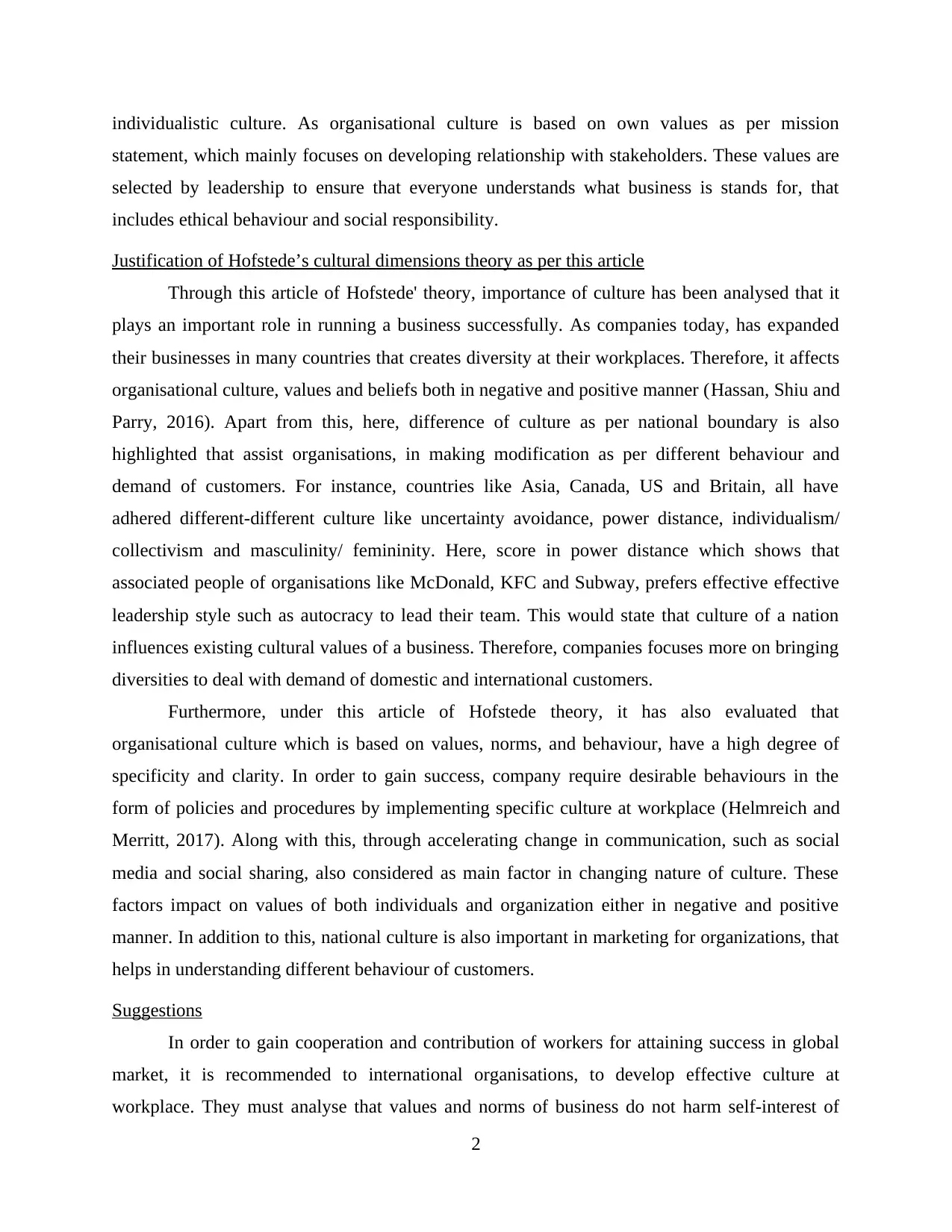
individualistic culture. As organisational culture is based on own values as per mission
statement, which mainly focuses on developing relationship with stakeholders. These values are
selected by leadership to ensure that everyone understands what business is stands for, that
includes ethical behaviour and social responsibility.
Justification of Hofstede’s cultural dimensions theory as per this article
Through this article of Hofstede' theory, importance of culture has been analysed that it
plays an important role in running a business successfully. As companies today, has expanded
their businesses in many countries that creates diversity at their workplaces. Therefore, it affects
organisational culture, values and beliefs both in negative and positive manner (Hassan, Shiu and
Parry, 2016). Apart from this, here, difference of culture as per national boundary is also
highlighted that assist organisations, in making modification as per different behaviour and
demand of customers. For instance, countries like Asia, Canada, US and Britain, all have
adhered different-different culture like uncertainty avoidance, power distance, individualism/
collectivism and masculinity/ femininity. Here, score in power distance which shows that
associated people of organisations like McDonald, KFC and Subway, prefers effective effective
leadership style such as autocracy to lead their team. This would state that culture of a nation
influences existing cultural values of a business. Therefore, companies focuses more on bringing
diversities to deal with demand of domestic and international customers.
Furthermore, under this article of Hofstede theory, it has also evaluated that
organisational culture which is based on values, norms, and behaviour, have a high degree of
specificity and clarity. In order to gain success, company require desirable behaviours in the
form of policies and procedures by implementing specific culture at workplace (Helmreich and
Merritt, 2017). Along with this, through accelerating change in communication, such as social
media and social sharing, also considered as main factor in changing nature of culture. These
factors impact on values of both individuals and organization either in negative and positive
manner. In addition to this, national culture is also important in marketing for organizations, that
helps in understanding different behaviour of customers.
Suggestions
In order to gain cooperation and contribution of workers for attaining success in global
market, it is recommended to international organisations, to develop effective culture at
workplace. They must analyse that values and norms of business do not harm self-interest of
2
statement, which mainly focuses on developing relationship with stakeholders. These values are
selected by leadership to ensure that everyone understands what business is stands for, that
includes ethical behaviour and social responsibility.
Justification of Hofstede’s cultural dimensions theory as per this article
Through this article of Hofstede' theory, importance of culture has been analysed that it
plays an important role in running a business successfully. As companies today, has expanded
their businesses in many countries that creates diversity at their workplaces. Therefore, it affects
organisational culture, values and beliefs both in negative and positive manner (Hassan, Shiu and
Parry, 2016). Apart from this, here, difference of culture as per national boundary is also
highlighted that assist organisations, in making modification as per different behaviour and
demand of customers. For instance, countries like Asia, Canada, US and Britain, all have
adhered different-different culture like uncertainty avoidance, power distance, individualism/
collectivism and masculinity/ femininity. Here, score in power distance which shows that
associated people of organisations like McDonald, KFC and Subway, prefers effective effective
leadership style such as autocracy to lead their team. This would state that culture of a nation
influences existing cultural values of a business. Therefore, companies focuses more on bringing
diversities to deal with demand of domestic and international customers.
Furthermore, under this article of Hofstede theory, it has also evaluated that
organisational culture which is based on values, norms, and behaviour, have a high degree of
specificity and clarity. In order to gain success, company require desirable behaviours in the
form of policies and procedures by implementing specific culture at workplace (Helmreich and
Merritt, 2017). Along with this, through accelerating change in communication, such as social
media and social sharing, also considered as main factor in changing nature of culture. These
factors impact on values of both individuals and organization either in negative and positive
manner. In addition to this, national culture is also important in marketing for organizations, that
helps in understanding different behaviour of customers.
Suggestions
In order to gain cooperation and contribution of workers for attaining success in global
market, it is recommended to international organisations, to develop effective culture at
workplace. They must analyse that values and norms of business do not harm self-interest of
2
Paraphrase This Document
Need a fresh take? Get an instant paraphrase of this document with our AI Paraphraser
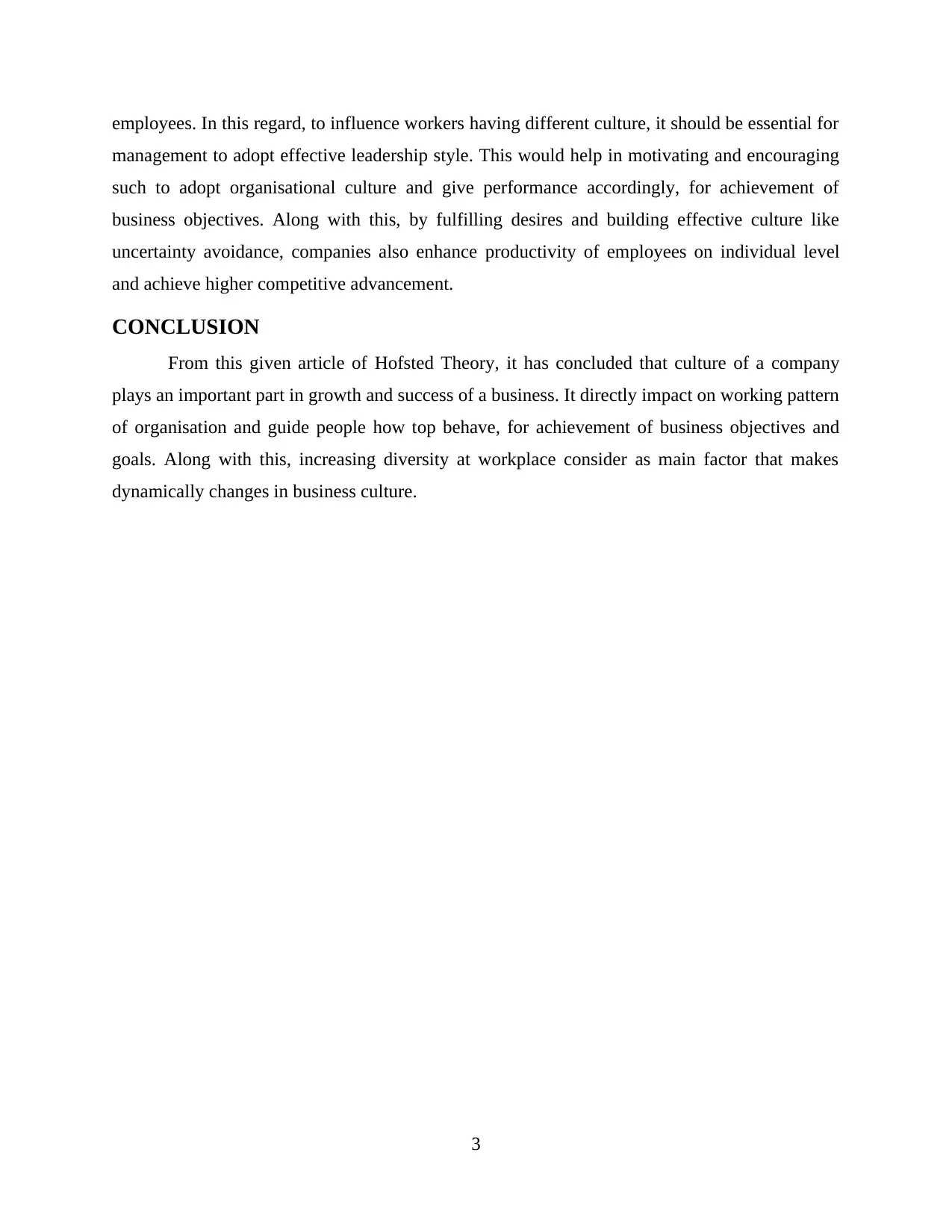
employees. In this regard, to influence workers having different culture, it should be essential for
management to adopt effective leadership style. This would help in motivating and encouraging
such to adopt organisational culture and give performance accordingly, for achievement of
business objectives. Along with this, by fulfilling desires and building effective culture like
uncertainty avoidance, companies also enhance productivity of employees on individual level
and achieve higher competitive advancement.
CONCLUSION
From this given article of Hofsted Theory, it has concluded that culture of a company
plays an important part in growth and success of a business. It directly impact on working pattern
of organisation and guide people how top behave, for achievement of business objectives and
goals. Along with this, increasing diversity at workplace consider as main factor that makes
dynamically changes in business culture.
3
management to adopt effective leadership style. This would help in motivating and encouraging
such to adopt organisational culture and give performance accordingly, for achievement of
business objectives. Along with this, by fulfilling desires and building effective culture like
uncertainty avoidance, companies also enhance productivity of employees on individual level
and achieve higher competitive advancement.
CONCLUSION
From this given article of Hofsted Theory, it has concluded that culture of a company
plays an important part in growth and success of a business. It directly impact on working pattern
of organisation and guide people how top behave, for achievement of business objectives and
goals. Along with this, increasing diversity at workplace consider as main factor that makes
dynamically changes in business culture.
3
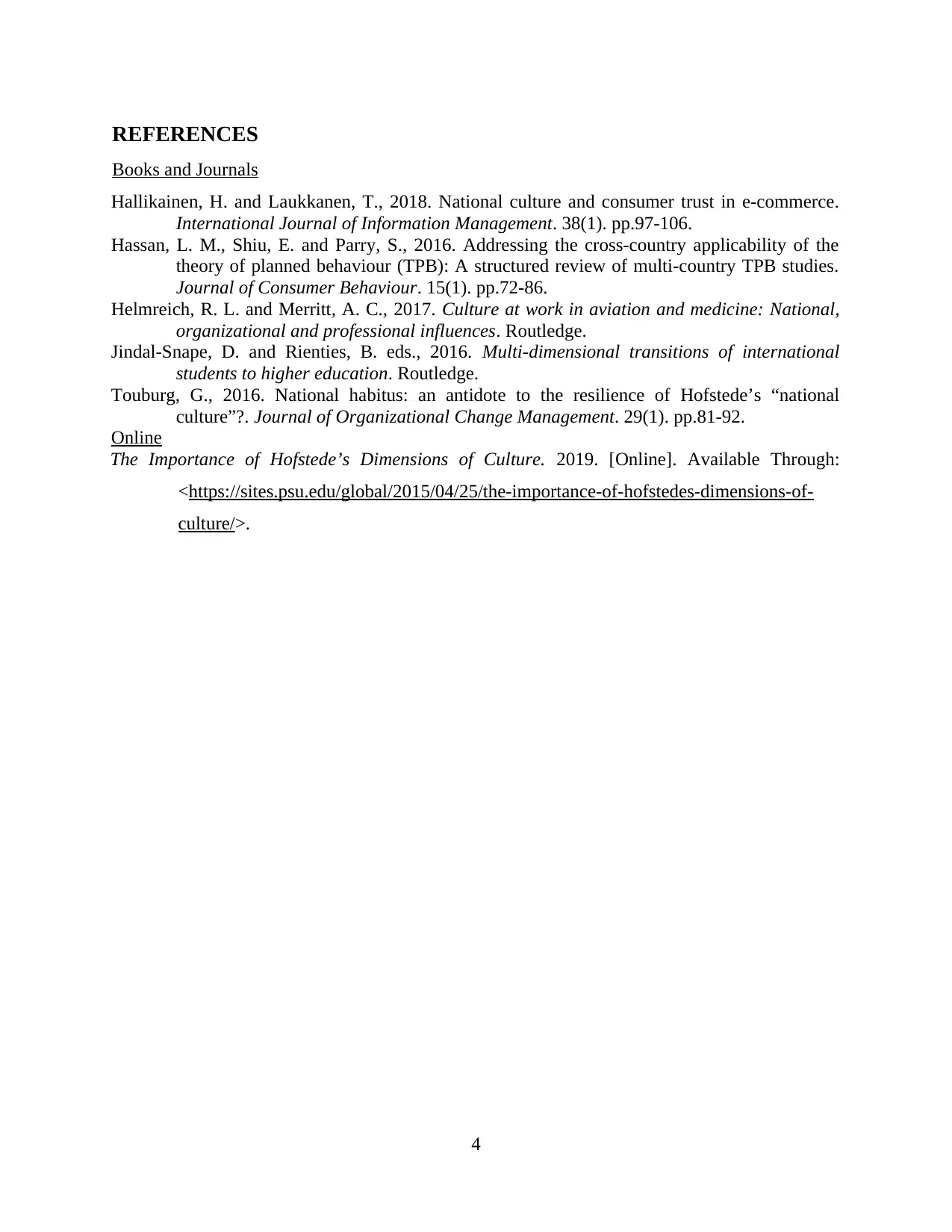
REFERENCES
Books and Journals
Hallikainen, H. and Laukkanen, T., 2018. National culture and consumer trust in e-commerce.
International Journal of Information Management. 38(1). pp.97-106.
Hassan, L. M., Shiu, E. and Parry, S., 2016. Addressing the cross‐country applicability of the
theory of planned behaviour (TPB): A structured review of multi‐country TPB studies.
Journal of Consumer Behaviour. 15(1). pp.72-86.
Helmreich, R. L. and Merritt, A. C., 2017. Culture at work in aviation and medicine: National,
organizational and professional influences. Routledge.
Jindal-Snape, D. and Rienties, B. eds., 2016. Multi-dimensional transitions of international
students to higher education. Routledge.
Touburg, G., 2016. National habitus: an antidote to the resilience of Hofstede’s “national
culture”?. Journal of Organizational Change Management. 29(1). pp.81-92.
Online
The Importance of Hofstede’s Dimensions of Culture. 2019. [Online]. Available Through:
<https://sites.psu.edu/global/2015/04/25/the-importance-of-hofstedes-dimensions-of-
culture/>.
4
Books and Journals
Hallikainen, H. and Laukkanen, T., 2018. National culture and consumer trust in e-commerce.
International Journal of Information Management. 38(1). pp.97-106.
Hassan, L. M., Shiu, E. and Parry, S., 2016. Addressing the cross‐country applicability of the
theory of planned behaviour (TPB): A structured review of multi‐country TPB studies.
Journal of Consumer Behaviour. 15(1). pp.72-86.
Helmreich, R. L. and Merritt, A. C., 2017. Culture at work in aviation and medicine: National,
organizational and professional influences. Routledge.
Jindal-Snape, D. and Rienties, B. eds., 2016. Multi-dimensional transitions of international
students to higher education. Routledge.
Touburg, G., 2016. National habitus: an antidote to the resilience of Hofstede’s “national
culture”?. Journal of Organizational Change Management. 29(1). pp.81-92.
Online
The Importance of Hofstede’s Dimensions of Culture. 2019. [Online]. Available Through:
<https://sites.psu.edu/global/2015/04/25/the-importance-of-hofstedes-dimensions-of-
culture/>.
4
⊘ This is a preview!⊘
Do you want full access?
Subscribe today to unlock all pages.

Trusted by 1+ million students worldwide
1 out of 6
Related Documents
Your All-in-One AI-Powered Toolkit for Academic Success.
+13062052269
info@desklib.com
Available 24*7 on WhatsApp / Email
![[object Object]](/_next/static/media/star-bottom.7253800d.svg)
Unlock your academic potential
Copyright © 2020–2025 A2Z Services. All Rights Reserved. Developed and managed by ZUCOL.



